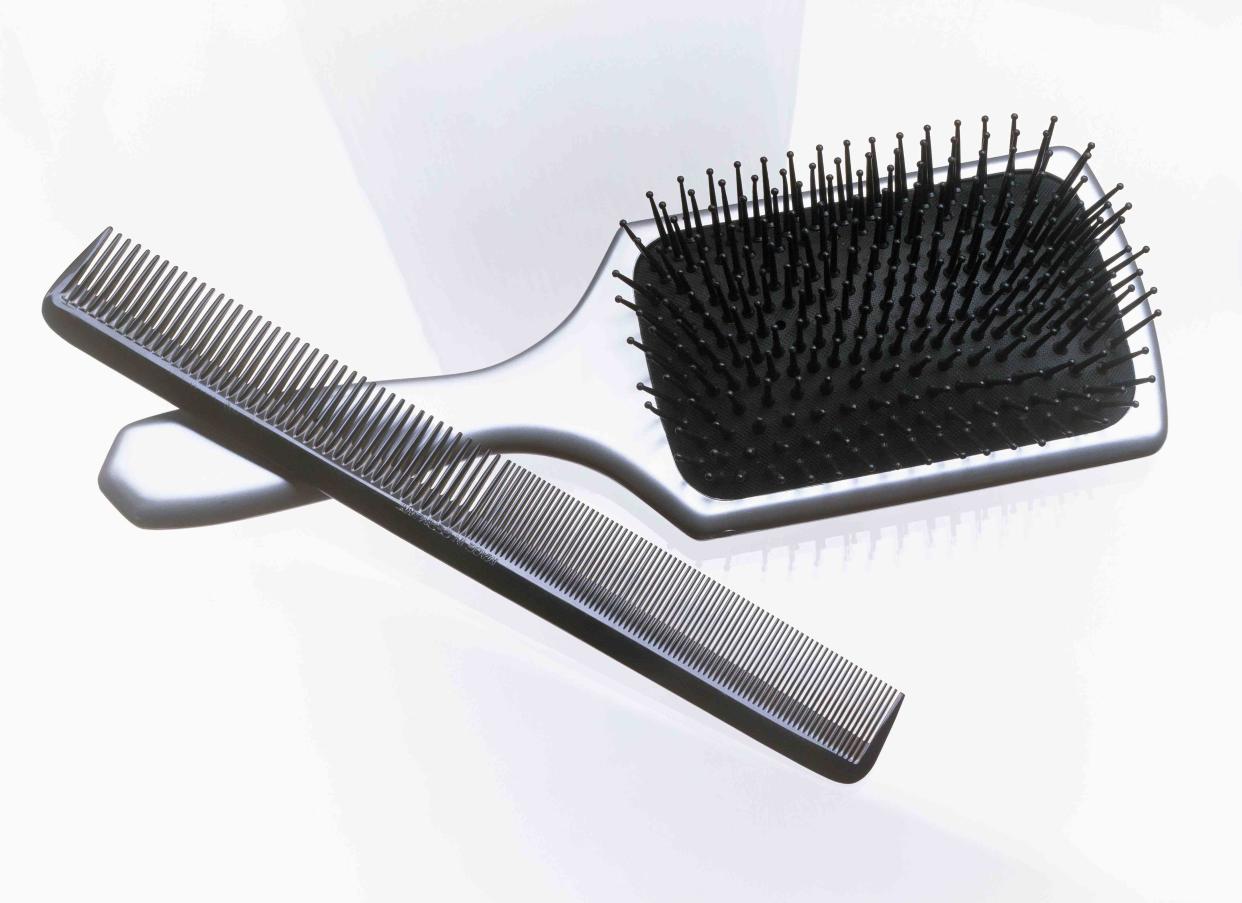How to Clean Your Brushes and Combs, According to Experts

Reviewed by Sky Kim
In the midst of sulfate-free shampoos, scrubs, and masks, we tend to forget another important part of keeping our hair and scalp healthy: cleaning our combs and brushes. But it's not enough to detangle and discard that old hair that has been on your tools for weeks (or longer). Oils and product residue can build up and get between the grooves, leading to unsanitary tools, which pretty much negates every other step in your haircare routine. But it doesn't have to be that way.
"Washing and maintaining your brushes and combs isn't as mainstream as it should be. Hair contains its own bacteria, yeast, dirt, and oil, and much of this accumulates on our tools each time we use them," says board-certified dermatologist Dr. Rachel Nazarian. "Every time you brush your hair you accumulate dead skin cells, dirt, bacteria, and oil onto your brush, and every time you use your brush some of these things transfer back to your hair."
We asked Nazarian and hair artist and salon founder Gina Rivera how to properly clean styling tools, so the next time you comb and brush your hair, your scalp and strands will thank you.
Meet the Expert
Rachel Nazarian, MD, FAAD, is a board-certified dermatologist at Schweiger Dermatology in New York City.
Gina Rivera is a hair artist and founder of Phenix Salon Suites.
Keep reading for a tutorial on how to clean your combs and brushes the right way.
Gather Your Materials
Combs and/or brushes that need cleaning
Shampoo
An old toothbrush
Baking soda (optional)
Alcohol or Barbicide disinfectant
Pull Loose Hairs Out of Your Brush
Begin by gently pulling any loose hairs out of your comb and brush by hand. Ideally, this is something you do after each time you brush your hair. If you don't do it on a daily basis, this may take some time, but don't worry about getting each and every hair out of the bristles. Just try and dislodge as many loose ones as you can before moving on.
Use a Comb to Pull Out Hairs
Now you can use the end of your comb (or the pointy end of a makeup brush if you don't have a comb handy), to remove additional hairs left behind from the first pass. Start at the base of the brush and move the comb upwards, pulling away hairs as you go. Discard the hair as you go through the process. If you're cleaning various combs, use one with the finest teeth for this step; the closely-spaced teeth will remove more hair than a wide-tooth one.
Dunk Combs and Brushes in Water
Combs are actually super easy to clean. Much like they do in salons, you can just let them soak in alcohol or Barbecide. For brushes, it's a little more complex.
Hair artist and salon founder Gina Rivera says to fill a clean sink with lukewarm, soapy water. Add a teaspoon or two of shampoo (clarifying shampoo works well for cleaning since they're designed to remove oily buildup and residue from the hair, but general shampoo is fine to use, too), and then completely submerge your hair tools in the water and let them soak for about 20 to 30 minutes. To cut any additional oil, add a tablespoon of baking soda. "Be sure to rinse thoroughly, as you don't want any dried shampoo on your brushes in addition to residue," says Rivera.
"For people who use daily hair products, or more frequently use items like dry shampoo before brushing, consider washing your combs or brushes every one to two weeks. For those who use hair products less often, once a month cleansing is appropriate," says Nazarian. "Using a shampoo to clean your brushes or combs ensures the natural hair oils and dirt that are transferred from your hair are appropriately and effectively removed."
Byrdie Tip
Avoid boiling your tools or using bleach. The high temperatures of boiling water can break down your tools, cutting their length of use by a significant amount. Plus, bleach can be difficult to completely wash out of bristles, leaving you at risk of getting bleach on your hair the next time you brush it.
Use an Old Toothbrush to Clean Between the Bristles
Use a toothbrush to very gently clean in between the bristles. If you want to add a little more shampoo to the toothbrush to combat greasy residue you can. Keep in mind that a wide tooth comb will have less buildup than a fine tooth comb, but you should still clean them all the same.
"Without regular cleansing, your brush or comb becomes an absolute nest of bacteria, dead skin cells and dirt," cautions Nazarian.
Allow Time to Dry
When you’re done cleaning, Nazarian recommends letting your hair tools sit out to dry fully (about a day) before you use them again. Place your combs and brushes on a towel, washcloth or paper towel and let them air dry. Combs dry relatively quickly, but it may take a day or more for your brush to completely dry.
Store Your Tools Properly
Once they have air-dried, store your brushes with the bristles down in order to let as much of the water drain as possible. It also might be a good idea to label which brushes you use most frequently and to keep track of when they were last cleaned (Rivera recommends "once a week for heavy use and twice a month for moderate use").
Up Next: Here are the best hair brushes for your hair type.
Read the original article on Byrdie.
